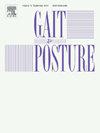The effect of acetabular fracture surgery on gait biomechanics; A prospective longitudinal cohort study
IF 2.2
3区 医学
Q3 NEUROSCIENCES
引用次数: 0
Abstract
Study purpose
Acetabular fractures are severe injuries that can result in altered gait patterns. These changes may arise from the injury itself, pain related adaptations, and the impact of surgery. The aim of this study was to gain insight into frontal, sagittal and transverse plane gait deviations in patients after surgically treated acetabular fractures during rehabilitation, compared to healthy controls.
Methods
In this prospective longitudinal cohort study instrumented gait analysis was conducted at standardised speed, self-selected speed and fast speed in the patient’s group at 3-, 6- and 12-months post-surgery, while matched healthy controls underwent a single assessment. Spatiotemporal parameters and frontal, sagittal and transverse plane hip, pelvis and thorax kinetics and kinematics were analysed. Statistical analysis was conducted using Statistical Parametric Mapping.
Results and conclusions
Fourteen patients surgically treated for an acetabular fracture and fourteen controls were included. At 3 months post-surgery, patients exhibited reduced self-selected gait speed, cadence, and stride length compared to 6- and 12 months of follow-up and compared to the healthy controls. Additionally, hip range of motion and moment were decreased at 3 months but returned to normal levels by 6 months. These findings suggest that the compensatory strategy for offloading the hip joint may involve temporarily reducing spatiotemporal parameters, range of motion, and moment, thereby minimizing the required hip abduction muscle force.
髋臼骨折手术对步态生物力学的影响一项前瞻性纵向队列研究
研究目的髋臼骨折是一种可导致步态改变的严重损伤。这些变化可能是由损伤本身、疼痛相关的适应和手术的影响引起的。本研究的目的是了解髋臼骨折术后患者在康复期间的额、矢状面和横向步态偏差,并与健康对照组进行比较。方法在这项前瞻性纵向队列研究中,分别在术后3个月、6个月和12个月对患者组进行标准化速度、自我选择速度和快速步态分析,而匹配的健康对照组进行单一评估。分析了时空参数以及髋、骨盆和胸腔的正、矢状面和横切面动力学和运动学。采用统计参数映射法进行统计分析。结果与结论14例髋臼骨折患者接受手术治疗,对照组14例。术后3个月,与随访6个月和12个月以及健康对照组相比,患者表现出自我选择的步态速度、节奏和步长有所减少。此外,髋关节活动度和力矩在3个月时下降,但在6个月时恢复正常水平。这些研究结果表明,髋关节减压的代偿策略可能包括暂时减少时空参数、运动范围和力矩,从而使所需的髋关节外展肌力最小化。
本文章由计算机程序翻译,如有差异,请以英文原文为准。
求助全文
约1分钟内获得全文
求助全文
来源期刊

Gait & posture
医学-神经科学
CiteScore
4.70
自引率
12.50%
发文量
616
审稿时长
6 months
期刊介绍:
Gait & Posture is a vehicle for the publication of up-to-date basic and clinical research on all aspects of locomotion and balance.
The topics covered include: Techniques for the measurement of gait and posture, and the standardization of results presentation; Studies of normal and pathological gait; Treatment of gait and postural abnormalities; Biomechanical and theoretical approaches to gait and posture; Mathematical models of joint and muscle mechanics; Neurological and musculoskeletal function in gait and posture; The evolution of upright posture and bipedal locomotion; Adaptations of carrying loads, walking on uneven surfaces, climbing stairs etc; spinal biomechanics only if they are directly related to gait and/or posture and are of general interest to our readers; The effect of aging and development on gait and posture; Psychological and cultural aspects of gait; Patient education.
 求助内容:
求助内容: 应助结果提醒方式:
应助结果提醒方式:


